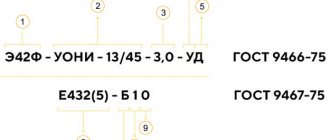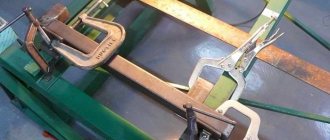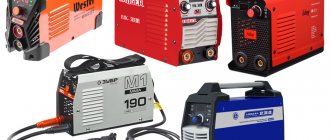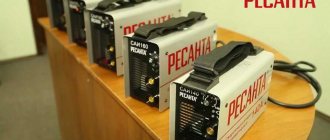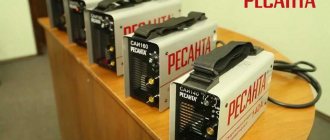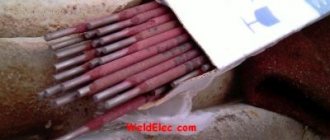05/27/2020 Author: VT-METALL
Issues discussed in the material:
- What equipment is used for welding work using electric arc welding?
- What equipment is used for gas welding
- Plasma welding equipment used
- Necessary equipment for laser metal welding
- Requirements for the use of welding equipment
Welding equipment differs depending on the chosen technology. But one requirement must always be met - the result must meet quality requirements, and the welder’s work must be safe and productive.
In our article we will tell you not only about the types of equipment that are used when using various welding technologies - plasma, gas, laser, etc., but also provide safety requirements that must be observed.
Electric arc welding equipment
Manual arc welding is performed using generators, transformers or rectifiers. The choice of settings is influenced by the type and complexity of the upcoming processing. It is important for equipment to meet certain requirements. It should:
- have a special device that allows you to control the current strength;
- function without disruption in the event of a short circuit;
- operate at idle speed, maintaining the welding arc, with the electrical circuit open;
- have high dynamic capabilities that allow you to restore functionality after a short circuit;
- have external indicators.
Welding equipment used at home has several differences. The first is the maximum values of electric current. The second is the time required to operate and generate maximum current.
- Generators.
The generator requires direct current to operate, providing an uninterrupted, stable welding arc. Structurally, the device consists of:
- stator with magnetic poles;
- armatures with collectors and windings.
When the armature rotates in the magnetic field created by the stator poles, the windings produce alternating current, which is converted into direct current by the collectors.
The armature is driven by an electric motor located on the same shaft. The equipment is called a welding converter. Installations for welding work are equipped with internal combustion engines that are used to start the rotating device. They are distinguished by the ability to weld workpieces without resorting to the use of external sources of electricity.
We recommend articles on metalworking
- Steel grades: classification and interpretation
- Aluminum grades and areas of their application
- Defects in metal products: causes and search methods
- Rectifiers.
The power source for welding equipment is a rectifier, which includes a control device, a rectifier unit and a transformer. It provides the electric arc with a direct current passing through the primary winding and a block of silicon or selenium rectifiers. To obtain a falling external characteristic, the welding equipment is equipped with an additional choke. In the production of standard rectifiers, a three-phase circuit is used, the advantages of which are a large number of voltage ripples, which allows the load to be evenly distributed in the circuit.
- Transformers.
Transformers ensure the stability of the electric arc. Therefore, this piece of welding equipment must meet certain parameters. Typically, this value is the droop characteristic, since many transformers are used for argon arc welding or submerged arc processing.
The frequency of industrial alternating current in Russia corresponds to 50 Hz. The task of the transformer is to convert high voltage to lower voltage - to the level required for welding work. The value of the secondary voltage indicator, taking into account no-load, is 60–75 V, the low current varies from 65 to 100 A. A stable electric arc is obtained at a voltage of 75–80 V.
Specifications
Supply voltage
This is the first thing you should pay attention to when buying a welding machine. This value can be equal to 220 or 380 volts. As a rule, household appliances are made for a voltage of 220 volts. In places that allow the use of a three-phase network, it is more convenient to work with 380-volt devices. But if you plan to work in different places, then it is better to choose a 220-volt device based on a simple consideration: a 220-volt network is available everywhere, but 380 may not be available.
Maximum electrode diameter
This parameter indirectly indicates the thickness of the metal that the welding machine is capable of welding. Naturally, many people strive to choose devices with the largest possible electrode diameter and fall into the trap of unscrupulous sellers who often inflate this figure.
Welding current type
This is a very important characteristic. The list of metals that can be welded on this machine depends on the type of welding current (AC, DC). It should be noted that the choice has already been made for you. The vast majority of welders prefer DC welding. Therefore, more than 99% of all machines are produced with constant welding current.
Open circuit voltage
The stability of the arc ignition depends on this parameter. Until some time, high open-circuit voltage conflicted with the voltage allowed by safety regulations. Currently, the higher the open circuit voltage, the more pleasant it is to work with the device, and safety is ensured by the VRD function. With this function, the voltage on the electrode is only a few volts, and only when it touches the metal does the voltage rise to hundreds of volts.
Switching period
This is a very important value. It can be found in the technical characteristics of welding machines in the following form: “PV = 60%”. This means that the device can operate 60% of the cycle, and 40% must cool down. In Russia, a five-minute cycle is adopted, from which it is clear that the device must cool down for two minutes after every three minutes of operation. This is not bad at all for gardening and garage work and is completely undesirable for devices operating even in small-scale production.
Gas welding equipment
- Water seal.
To provide effective fire protection for the pipe, acetylene generator and other elements, a water seal is used in the form of a reverse draft from a gas burner. It is important to maintain a certain water level in the seal. This piece of equipment for welding work is located between the torch and the acetylene pipe.
- Gas cylinders.
The color of the cylinders depends on the gas filling them. However, the top of any vessel remains unpainted. This is necessary to ensure that the paint does not come into contact with the gas. Another technical nuance is to prohibit the installation of copper valves on acetylene cylinders, since there is a risk of explosion due to the interaction of acetylene and copper.
Completely odorless and colorless, O2 acts as a catalyst, starting the melting process during welding. Oxygen is stored and transported in cylinders, the pressure in which is constant.
VT-metall offers services:
Compliance with safety rules when working with oxygen cylinders is mandatory, since the risk of fire occurs, for example, when gas comes into contact with technical oil.
The presence of heat sources or direct sunlight in gas cylinder storage areas is prohibited.
To obtain oxygen for welding work, special equipment is used that converts atmospheric air.
Depending on the purity, there are three types of oxygen:
- highest – gas concentration is 99.5%;
- first – 99.2%;
- the second – 98.5%.
The second most common gas is acetylene, it is used for welding and also for cutting metals. This colorless and odorless gas explodes when heated or pressurized. Calcium carbide and water are used to produce it.
Despite its higher cost, it has certain advantages, which makes it popular for welding work. Acetylene has a higher combustion temperature compared to cheap methane, propane or kerosene vapor.
- Flux and filler wire.
The weld is formed from flux and filler wire. The latter should not have mechanical contamination or corrosion. The metal thread can, in certain cases, be replaced by a strip of metal similar to that from which the workpiece being welded is made.
Fluxes protect the weld pool from the negative effects of the external environment. Flux mixtures consist of borax and boric acid, applied either directly to the workpiece or to the filler wire.
You can do without flux only when working with carbon steels. It is impossible to weld copper, aluminum and their alloys without this substance.
- Hoses for various purposes.
Hoses in welding equipment are used to convey gases and hot liquids. Since they operate under pressure, they must meet certain technical requirements.
Three types of hoses are available:
- with a red stripe – withstands pressure up to 6 atmospheres;
- with a yellow stripe – intended for flammable substances;
- with a blue stripe - withstands pressure up to 20 atmospheres.
- Gas-burners.
A burner mixer is used to mix gases and vapors of flammable liquids. Manufacturers offer a variety of burners, varying depending on power, the presence of an injector, etc.
- Gearbox.
Required in welding equipment with high gas pressure.
This element is necessary to reduce the pressure of the gas leaving the cylinder. Gearboxes can be direct or reverse acting. Working with liquefied gases requires the use of modern silver-plated models. Such equipment does not allow the gas to freeze at the outlet of the cylinder.
What types of welding machines are suitable for home
- It is advisable to weld pipes for heating and water supply with an inverter, the current of which is in the range from 20 to 200 A, the cable is 1.8 m, and the power supply is from 140 to 250 V, weighing three kilograms and a cycle of 60 percent.
- Car repair, which involves welding on a thick frame and a thin body, involves the use of a type of welding machine such as a semi-automatic machine with wire setting from 0.8 to 1.2 mm, in the range of 20–300 A, a cable length of three meters, and also with a power supply from 180 to 250 V and a cycle from 80 to 100 percent. The weight of the equipment can be six kilograms or more. Large enterprises use a three-phase model at 380 V.
- In order to weld doors, fences and gates, a simple 40–250 A transformer is used, the cable length reaches two meters, and the cycle is 60%. Power supply from 220 to 230 V, depending on the local network.
- To weld a greenhouse, support, canopy or balcony, use a lightweight inverter-type welding machine, weighing up to 3 kg, the cable length of which is 1.8 m. The current strength can be in the range from 30 to 180 A, since the thickness of the metal wall is no more than 2 mm.
- To weld the furnace and heat exchanger, you will need a powerful inverter from 300 to 500 A with a cycle from 80 to 100% and 7.5 kW. It is possible to use three-phase power supply.
Plasma welding equipment used
Equipment for welding work (for plasma processing) consists of the following elements:
- burners (plasmatron);
- power source (inverter);
- cylinder with plasma-forming gas;
- protective gas cylinder;
- water cooling systems;
- cable package.
A welding torch is a complex device consisting of electrodes, pipelines for supplying gases and coolant, and an electrical cable for supplying power to the electrode.
The design of the torch is influenced by the power of the welding equipment. Low-power devices are equipped with burners with a retractable cathode, which, through a control button, is connected to the anode nozzle and excites the arc.
Manual plasma welding is performed using a gun-shaped torch that is comfortable to hold in your hands. Plasma-water welding is carried out by a combustion device in the form of a gun, which also has a discharge chamber and a steam-generating device.
More powerful equipment for welding work is equipped with torches with a fixed cathode. It consists of:
- cathode;
- cavities for working gas;
- cavities for shielding gas;
- anode (with a cavity for cooling);
- housings.
Torches for high-power welding equipment do not have handles, as they are attached directly to manipulators or machines.
The power source in the equipment is inverters, which have almost completely replaced transformer energy sources. Thanks to modern pulse converters based on IGBT transistors, a stable operating current is provided, which is adjustable to operate the equipment in various modes.
Necessary equipment for laser metal welding
Laser welding equipment has different dimensions and power, but all of it operates on a solid or gaseous working fluid. The difference lies in the way the light emission occurs. Metal processing on any type of machine is performed in the same way.
- Solid state installations.
The devices are used in continuous radiation mode. They are characterized by higher operating frequencies, as well as limited efficiency and power. Solid-state equipment is used when working with small-sized and thin-walled products.
- Gas apparatus.
If it is necessary to weld thicker workpieces, equipment with a gaseous working fluid is required. Excitation of radiation in a gaseous medium occurs due to an electrical discharge. This equipment is suitable for working with workpieces up to 20 mm thick. With this technology, the beam power increases and the efficiency also increases. Equipment for welding work has a complex device with a fragile glass bulb.
- Hybrid installations.
Parts with complex configurations and thick sheet metals are processed using hybrid welding systems. In addition to the laser head, they have a semi-automatic electric arc burner.
The filler material is a wire that fills the welding gap and forms the weld.
Requirements for the use of welding equipment
Requirements for the operation of welding equipment for electron beam welding are set out in the “Rules for the operation of high-voltage electrical installations”. The risks of industrial injuries can be minimized by equipping the welding operator’s workplace with lifting and transport mechanisms (telpher, trolley, etc.), as well as securely securing cylinders with compressed and liquefied gas.
The greatest danger in gas welding is the explosion of the acetylene-air mixture in the event of improper operation of acetylene generators, calcium carbide and torches during a backfire. There is a possibility of oxygen reducer valves catching fire if traces of oil come into contact with them or if the gas cylinder valve is suddenly opened. The most dangerous is the explosion of an oxygen cylinder, which is under high pressure.
If you handle the burner flame carelessly, the technician may get burned or cause a fire in the room. Gas welding and cutting of metals pose a danger to vision; visible rays have a negative effect on the retina and choroid of the eyes, invisible infrared rays have a negative effect on the cornea and lens of the eye.
Welders can engage in welding work only after passing the technical minimum according to safety regulations.
Welding work is prohibited from being carried out near flammable and flammable materials, including gasoline, kerosene, tow, shavings, etc.
If welding is carried out on an ongoing basis, then for work it is necessary to equip a room based on the minimum area required for one post - 4 m2 and the passage between workstations - at least 80 cm. Good ventilation must be provided in the room.
Working with welding equipment, including manual and mechanized oxygen cutting, welding and other types of gas-flame processing requires the use of closed-type safety glasses with glasses G-1, G-2 and G-3 by gas welders and gas cutters. The density of their glass filters must comply with the requirements of GOST 9497-60 with an acetylene consumption of up to 750 dm3/h - GS-12. Support personnel working with welders or cutters must be provided with safety glasses with glasses V-1, V-2 and V-3 in accordance with the requirements of GOST 9497-60.
Welding equipment - what is it, types, features
Without the welding process, it is impossible to imagine a single construction site, industrial production or solution to any everyday issues, and therefore it is not surprising that welding equipment is in constant demand. Today, welders have many welding methods and methods in their arsenal: using electrode or graphite rods with excellent conductive properties, using special welding wires, as well as based on gas, plasma, laser and other technologies.

